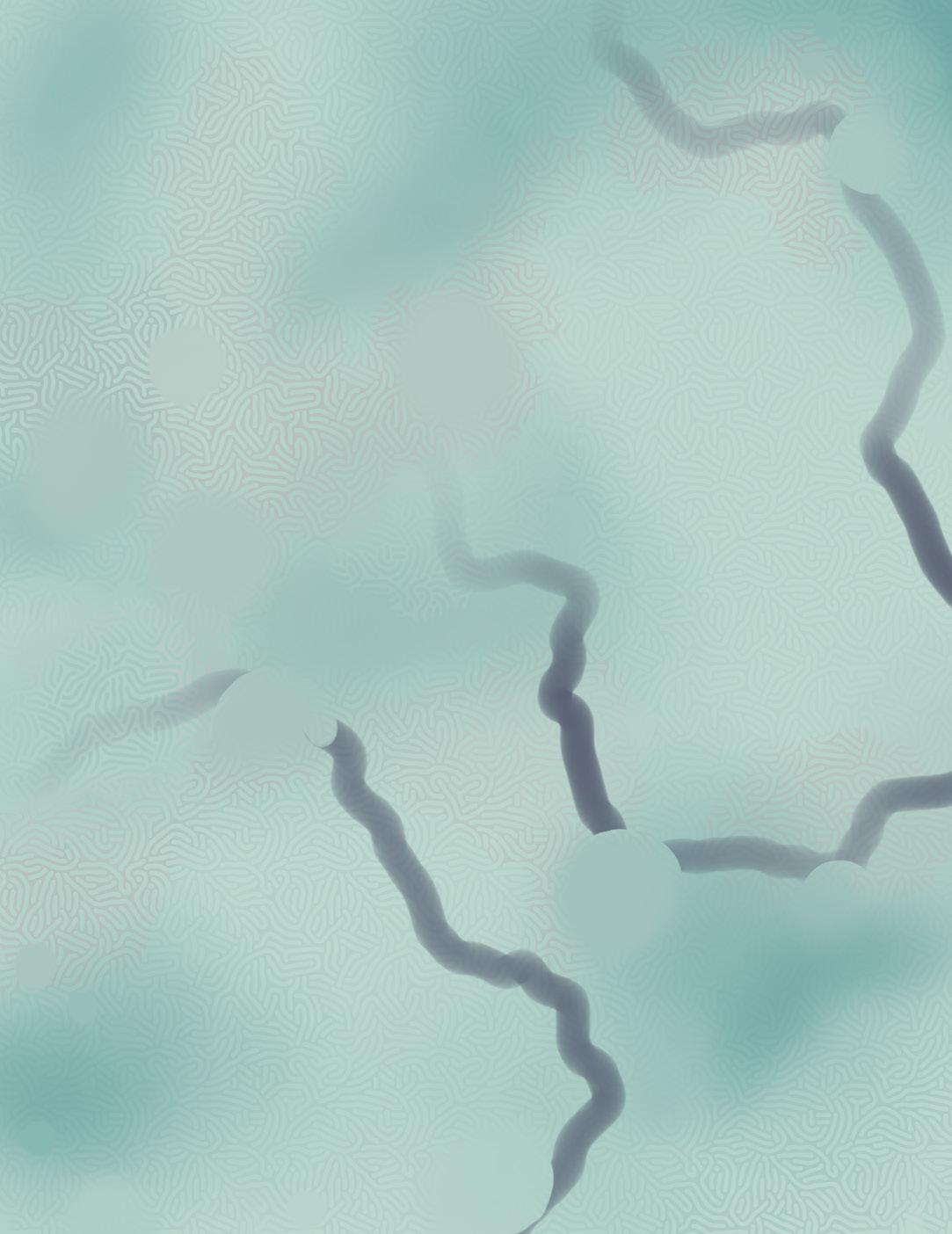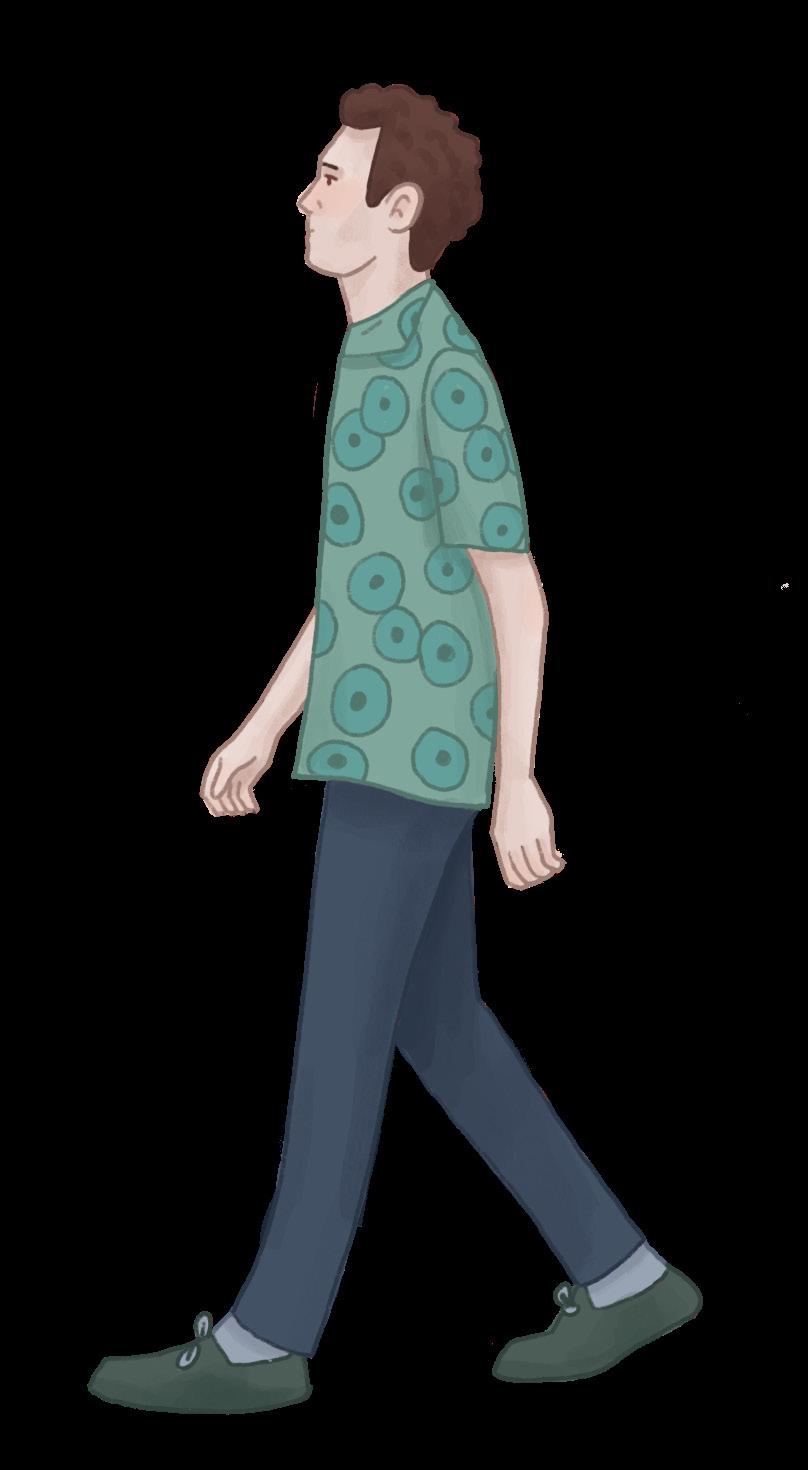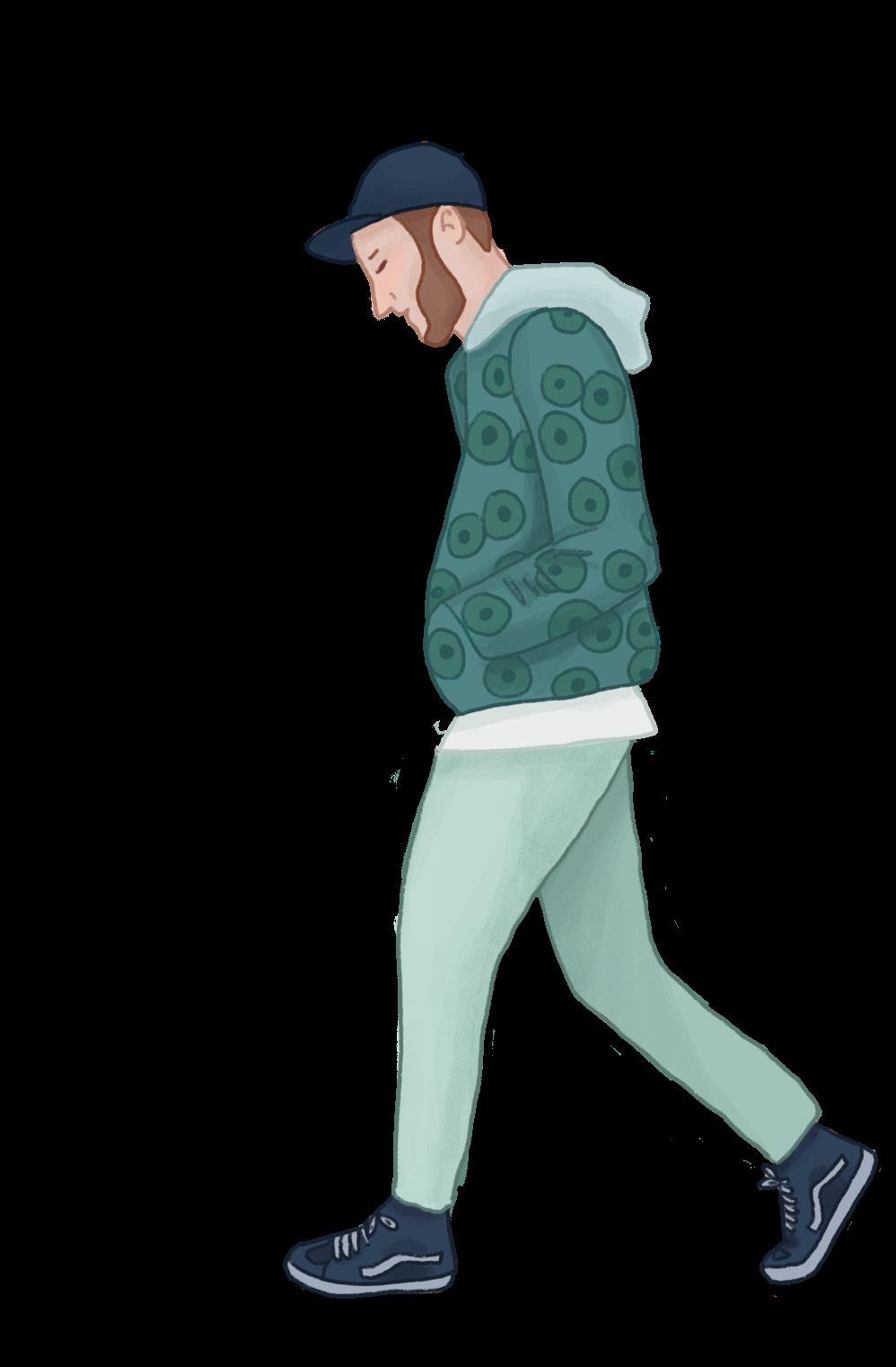CONTENTS




 BY OLIVER KELLEY
BY OLIVER KELLEY
When thinking of your immune system, what kind of image comes to mind? Is it one of matrices of mighty soldiers covered by shiny armor marching towards millions of brutish invaders, or that of friendly neighbors that always watch out for you in emergencies? The immune system is neither. When facing cancer—a disease that arises from the uncontrolled division of one’s own cells—the immune system plays a dual role. It both inhibits cancer growth and unwittingly provides opportunities for cancerous cells to escape without the body noticing.
Cancer, defned by Stanford Medicine as tumors that cause harm and potential death, was initially just a small group of cells dividing at an alarming rate. Slowly, this collection of cells forms a benign tumor, a tissue that encloses cells undergoing uncontrolled division. Benign tumors could transform into malignant tumors via metastasis, the delocalization of primary tumors, through processes such as the escape into the lymphatic system, and the development of secondary tumors at lymph nodes. As an organ surrounded by multiple lymph nodes, the breast is susceptible to metastasis. The American Cancer Society estimates that 43,700 lives will be taken by breast cancer this year. As our fundamental line of defense, the immune system is critical in every stage of breast cancer. Yet, studies reveal the controversial interactions between breast cancer and immune cells, in particular natural killer cells and macrophages.
The natural killer (NK) cell, a member of the innate immune system, can discriminate cells based on the presence of major histocompatibility complex (MHC) molecules. According to researchers from the University of Massachusetts, MHC molecules are proteins protruding from cell surfaces that help the immune system separate the body’s cells from foreign cells, protecting body cells from immune attacks. Though present on the surface of most body cells, MHC molecules are absent on tumor cells, which allows natural killer cells to distinguish and destroy them. When facing breast tumor cells, natural killer cells release the glycoprotein perforin which, according to researchers from the Medical University of Warsaw, creates pores on the tumor cell’s membranes that leads to apoptosis.

But what could possibly go wrong with the natural killer cell, the stern assassin that yearns to stife cancer in its cradle? It turns out that within the tumor microenvironment, the tumor-immune system interaction alters natural killer cell characteristics. Studies at Central South University show that the major surface receptor on natural killer cells, NKG2D, is suppressed by breast cancer cells in their tumor microenvironment. Therefore, natural killer cells lose the ability to identify tumorous cells. Through inactivating natural killer cells, tumor cells proliferate with less resistance. With the natural killer cells repressed, breast tumor cells could more easily migrate into lymphatic vessels, and resettle in the internal mammary lymph nodes, according to research published in Medical News Today.
Macrophages, which come in M1 and M2 subtypes, are another crucial element of the immune system. As the “big eaters” of our body, M1 macrophages engulf tumorous cells via phagocytosis and digest them through lysosomes, organelles containing hydrolytic enzymes that dissolve membranes. After digesting tumor cells, M1 macrophages act as antigenpresenting cells and present tumor-specifc antigens, proteins on cell membranes that denote the cell’s identity, to members of the adaptive immune system.
M2 macrophages, on the other hand, secrete growth factors and perform angiogenesis, the recruitment of
blood vessels to develop around the tumor. According to researchers at the University of Bristol, angiogenesis allows tumor cells to enter blood vessels and via capillaries, fuse into the lymphatic system. The macrophages that enter the tumor microenvironment are initially undiferentiated, meaning they can diferentiate into either M1 or M2 macrophages. However, tumor cells utilize cell-to-cell communication to induce almost all macrophages to diferentiate into M2, which, as stated by researchers at Wuhan university, signifcantly increases the chances of metastasis.
Adopting the “insider-outsider” perspective, it is startling to realize that neither the immune system nor cancer itself were outsiders. They are both components of our bodies. Yet, through uncontrolled and invasive growth, cancer transforms itself into an outsider, fghting against its host, the body. While our immune system, blinded by this spy in plain sight, treats cancer cells as one of our own.
 WRITTEN BY: MARINA ZHU
ILLUSTRATED
WRITTEN BY: MARINA ZHU
ILLUSTRATED

BY:
ABBY JONES
Editors-in-Chief: Lina Lew, Sharanya Sriram
Executive Editor: Anjali Iyangar
Editor-at-Large: Nicole Adamson
Production Editors: Tania Gallardo, Amber Hauw
Production Team: Dhathry Doppalapudi, Jacqueline Cheung, Irum Aamer
BACKGROUND ILLUSTRATION BY OLIVER KELLEY
Head Illustrator: Kristiana Wong


Staff Illustrators: Abby Jones, Oliver Kelley

Head Photographer: Harnoor Sidhu
Staff Photographer: Tommy Murphy
Head Tech Editor: Nicolas Bello Spring 2023 | Vol. 22| 2
UC San Diego is situated in a biodiversity hotspot; however, the eucalyptus trees towering over you come from the other side of the world. While native to Australia, today they can be found worldwide. In their nonnative habitats, eucalyptus trees are often used for windbreaks, ornamentally, and for economic proft. However, as with any invasive species, eucalyptus trees afect native animal and plant life in ecosystems globally, including here in La Jolla.
Why Are They Here?
Eucalyptus plantations are found in over 100 countries around the world. They were frst brought to the United States for timber during the Gold Rush when wood was scarce, according to Daniel Potter in a KQED article. These trees were used to manufacture wagons, carriages, railroad ties, and furniture, according to research by R. C. Kellison. However, Californians soon found that eucalyptus wood split and cracked easily, making it a poor choice for timber. The trees also had extensive roots that drained nearby wells. Even after discovering the shortcomings of eucalyptus wood, tree plantings increased in the early 1900s due to concerns of a timber famine. When the timber famine never came, farmers left eucalyptus as they were because they were not worth harvesting.
Eucalyptus populations increased due to government eforts as well. In 1870, the California State Board of Agriculture decided that human-planted eucalyptus forests for shade trees, timber, ointments, scented products, and bee pollination would be benefcial. By 1887, the State Board of Forestry became involved in the eucalyptus introduction program by establishing experiment stations to observe how eucalyptus trees would grow in California. This was in hopes to urge landowners to establish plantations; however, the board was disbanded in 1893 due to a hostile political climate of national debates over the merits of having a Federal forest reserve system, according to Mark V. Thornton, a consulting historian working for CAL FIRE. The introduction program was then left to the UC Berkeley College of Agriculture. Nearly a decade later, the many potential uses of eucalyptus trees for railroad spikes, furniture, and frewood led to a major expansion of the program to plant eucalyptus from 1905 to 1912. This expansion gave California the large forests of eucalyptus trees that are scattered around the state now, such as in La Jolla and San Francisco.
In La Jolla, eucalyptus trees were planted in 1911 by Torrey Pines forester Max Watson, who said that the eucalyptus “ofered [the land] the possibility of producing something,” according to Roger Anderson in the San Diego Reader in 1989. However, the poor quality of the wood ultimately made this venture unproftable too.
Ecological Impacts
Eucalyptus trees are very adaptable to new habitats, as they lack natural pests and are able to outcompete native plants. Existing animal and plant species are impacted by the introduction of eucalyptus trees in their habitats.
In addition to far-reaching root networks, the trees litter the ground with a detritus layer from shedding bark and leaves. This shedding prevents growth of native plants because the detritus “sufocates” new plant growth, according to the San Marcos Growers, a commercial wholesale nursery. In nonnative habitats, eucalyptus groves provide shelter to native animals. In Morro Bay, California there is a stand of eucalyptus trees that nest herons, cormorants,
WRITTEN BY: IAN HICKE PHOTO BY: TOMMY MURPHYand egrets as seen in a San Francisco Forest Alliance article. However, the bird biodiversity decreases in the presence of eucalyptus trees. A study done by Lucilene Jacobski compared bird populations in native habitats and plantations in Southern Brazil. The study showed that bird abundance was consistently more than double in native forests than in eucalyptus groves.
Eucalyptus also afects abiotic factors in the ecosystem. The high oil concentration in eucalyptus trees and its detritus can add fuel to dangerous fre conditions.
According to the National Park Service in 2006, the total fuel from eucalyptus calculated within Point Reyes National Seashore and Golden Gate National Recreation
Area is 30.84 tons per acre, compared to California Bay communities with 18.93 tons per acre and Coast Live Oak communities with 11.82 tons per acre. In the Oakland “Tunnel” Fire on October 20, 1991, known as the worst wildfre in California’s history, it was estimated that over 70 percent of the energy released through the combustion of vegetation was due to eucalyptus.
The Future of Eucalyptus
Some areas in San Diego have removed eucalyptus groves. At the San Diego Zoo, according to Roger Anderson, eucalyptus trees were initially used to immerse guests into a new environment; however, in 1989 more than 100 of those trees were removed to combat their competitiveness and invasive growth against other exotic species. Despite the negative impacts of eucalyptus trees, they are still planted and used worldwide. UC San Diego’s landscape sustainability worker, Chris Johnson, said that the university has a mandate to preserve the eucalyptus grove on campus because of its historical importance. This means that for every eucalyptus tree that is removed, a new one is planted somewhere else on campus.

In the eigth annual High School Essay Contest, the SQ Community Outreach team invited high school students to write a 500-750 word piece about invasive species. SQ hopes this experience will encourage and celebrate science communication among future scientists and inspire them to think about biology in a broader context. This year’s winner is a current high school senior at Mira Mesa High School and an incoming UCSD Bioengineering: Biotechnology student in Earl Warren college.
Having lived in San Diego for nearly all my life, ice plants—which typically are large, mat-forming coastal succulents native to South Africa—have always been a part of what I imagine in the local community. From the neighborhood gardens lining the sidewalks to the edges of railroads and the miles of blufs on beaches, there isn’t a place I can think of where I cannot fnd ice plants.
According to a historic analysis by Jaden Husser, with the intent to stabilize railroad tracks from erosion in the early 1900s, ice plants were introduced to California. Soon, they rose in popularity, allowing their spread into roadsides, ornamental purposes, and more. Highway ice plants quickly became one of the most popular iceplants in comparison to its various counterparts. Stretching from north of Humboldt County to as far south as Baja California, ice plants have become a coastal invader.

As 2023 began with one of the heaviest rainfalls in recent history for California, many people also saw the erosion of multiple beachside clifs due to their ice plant invasion. Ice plants, which are suited for well-drained soil and minimal watering, infate like water balloons and increase in weight, and contribute to eroding blufs at an increased rate. Bluf repair and prevention comes at a hefty cost. On top of disrupting COASTER and other railroads, projects such as the Coastal Commission’s bluf stabilization project in Del Mar’s cost 68 million dollars and took 3 years as of summer 2022. More surprisingly, this has not been the frst project for stabilization in the
area as previous repairs have been attempted in 2019 due to heavy rainfalls.
Ice plants, though heralded for its drought-resistant qualities, have decimated native organisms as a result of their shallowrooted thick mat formations which choke out all other native plants—including endangered, threatened, and rare plants—as well as altering soil composition in the environment. Ice plants release enough salt into the soil to inhibit other plant seeds from propagating. Additionally, the only way to remove ice plants is through labor-intensive hand-pulling as other methods such as using construction machinery risk damaging other native species in the area. Outcompeting native plants in water, light, and space; serving no purpose as a food source for animals; and only being able to be viably removable through hand pulling; ice plants have truly monopolized California coasts as a perennial fora.
However, there may be hope for removing this invader. I recently came across an Instagram video of food blogger Suzy (@sooziethefoodie) where she prepared an ice plant dish. Suzy dressed the ice plant in dashes of trufe soy sauce and lychee vinegar, grated ginger, kiwano melon spoonfuls, sprinkles of pomegranate, and several edible fowers all sitting in a shell-shaped fried tapioca sheet. In a video less than a minute long, ice plants changed from a mere pesky
neighborhood plant to an opportunity to expand California’s economy through edible delights.
By informing others about the ability to eat ice plants, the potential for ice plant removal seems more realistic, as previous attempts through hand-pulling volunteer work in concentrated patches always return with ice plant growth. Not only can local residents collect ice plants for food, but businesses and restaurants can begin specializing in cuisines that include ice plants to increase the removal of ice plants along California’s coasts. Consumption of ice plants is not new, as many have discovered its nutritious value, containing high levels in vitamins A, B, C, mineral salts, and isofavones, which can protect against breast cancer, menopausal symptoms, heart disease, osteoporosis, and more. Described as salty with a hint of citrus, many have already tried and enjoyed the versatility of ice plants in the kitchen. Steeped as teas, raw in salads for an additional crunch, garnishes, deep-fried, dried, pickled, and reduced into chutneys, the opportunities are endless as a nutrient-flled delicacy!